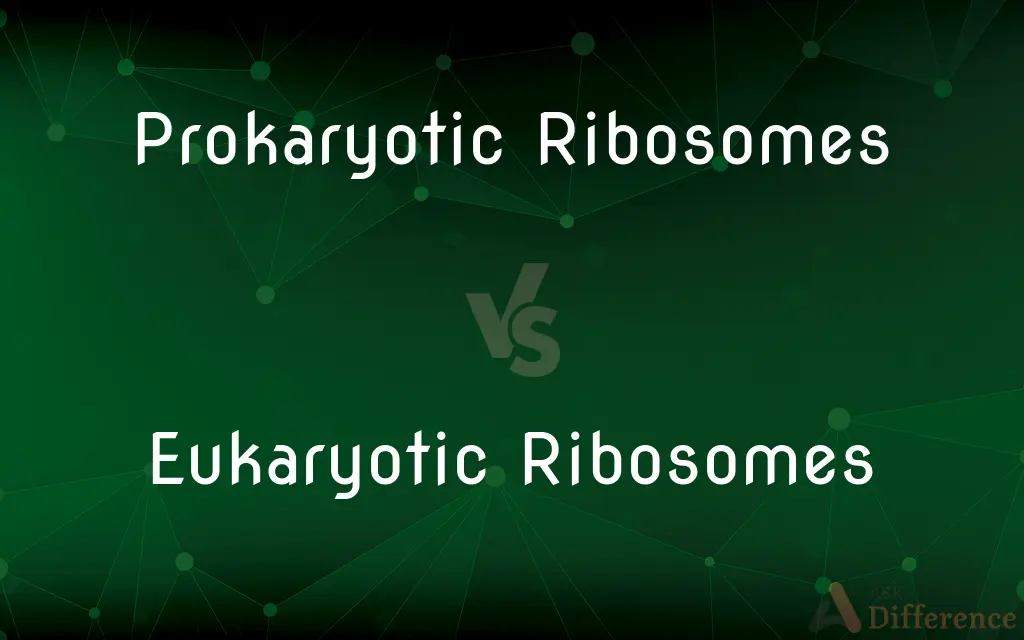Prokaryotic Ribosomes vs. Eukaryotic Ribosomes — What's the Difference?
By Tayyaba Rehman — Published on October 25, 2023
Prokaryotic Ribosomes are smaller (70S) structures in bacteria and archaea, while Eukaryotic Ribosomes are larger (80S) and found in eukaryotic cells.

Difference Between Prokaryotic Ribosomes and Eukaryotic Ribosomes
Table of Contents
ADVERTISEMENT
Key Differences
Prokaryotic Ribosomes and Eukaryotic Ribosomes are cellular machines essential for protein synthesis. However, they differ in their structures, sizes, and cellular locales. Prokaryotic Ribosomes are typically 70S, with "S" standing for Svedberg units, a measure of particle sedimentation rate. In contrast, Eukaryotic Ribosomes are 80S in size, reflecting their greater complexity and number of ribosomal RNA and proteins.
The presence of Prokaryotic Ribosomes is within the cytoplasm of bacteria and archaea. These ribosomes are crucial for the survival of these organisms, facilitating the assembly of amino acids into proteins. Eukaryotic Ribosomes, on the other hand, can be found both free-floating in the cytoplasm and bound to the endoplasmic reticulum in eukaryotic cells, aiding in protein synthesis for both intra- and extracellular purposes.
The difference in ribosomal structure between Prokaryotic Ribosomes and Eukaryotic Ribosomes has therapeutic implications. For instance, many antibiotics target Prokaryotic Ribosomes, inhibiting bacterial protein synthesis, without affecting the eukaryotic counterparts. This selective action underlines the structural and functional disparities between these ribosomal types.
Delving deeper, Prokaryotic Ribosomes consist of a 50S and a 30S subunit, while Eukaryotic Ribosomes are made of 60S and 40S subunits. Though seemingly just a matter of size, these differences influence the functionality, efficiency, and interactions of these ribosomes in their respective cellular environments.
In summary, both Prokaryotic Ribosomes and Eukaryotic Ribosomes serve the fundamental role of protein synthesis. Yet, their structural, size, and functional differences reflect the intricacies and distinctions of the cells they inhabit.
ADVERTISEMENT
Comparison Chart
Size
70S
80S
Location
Found in bacteria and archaea's cytoplasm.
Found in eukaryotic cells; both free in cytoplasm & on the endoplasmic reticulum
Subunits
50S and 30S
60S and 40S
Antibiotic Sensitivity
Often targeted by antibiotics.
Typically not affected by antibiotics targeting prokaryotic ribosomes.
Associated Organisms
Bacteria and Archaea
Eukaryotic organisms (animals, plants, fungi, protozoa)
Compare with Definitions
Prokaryotic Ribosomes
70S ribosomes present in bacteria and archaea.
Prokaryotic Ribosomes are essential for bacterial survival and replication.
Eukaryotic Ribosomes
Composed of 60S and 40S subunits.
The two distinct subunits of Eukaryotic Ribosomes combine during the translation process.
Prokaryotic Ribosomes
Integral to the translation of mRNA in prokaryotes.
Without functional Prokaryotic Ribosomes, bacteria cannot produce vital proteins.
Eukaryotic Ribosomes
Larger 80S ribosomes present in animals, plants, and fungi.
Eukaryotic Ribosomes can be found floating freely or attached to cellular structures.
Prokaryotic Ribosomes
Sensitive to certain antibiotics, leading to disrupted protein synthesis.
The specificity of some drugs to Prokaryotic Ribosomes ensures they don't harm human cells.
Eukaryotic Ribosomes
Integral to translating mRNA into proteins in eukaryotic cells.
Protein synthesis in human cells relies on the function of Eukaryotic Ribosomes.
Prokaryotic Ribosomes
Consist of 50S and 30S subunits.
The two subunits of Prokaryotic Ribosomes assemble during protein synthesis.
Eukaryotic Ribosomes
Cellular structures in eukaryotes essential for protein synthesis.
Eukaryotic Ribosomes attached to the endoplasmic reticulum help in synthesizing proteins for secretion.
Prokaryotic Ribosomes
Cellular structures in bacteria aiding protein synthesis.
Antibiotics often target Prokaryotic Ribosomes to halt bacterial growth.
Eukaryotic Ribosomes
Not typically the target of common antibiotics.
Most antibiotics focus on Prokaryotic Ribosomes, leaving Eukaryotic Ribosomes unaffected.
Common Curiosities
Where can you find Eukaryotic Ribosomes?
Eukaryotic Ribosomes are in eukaryotic cells, both free in the cytoplasm and on the endoplasmic reticulum.
What size are Prokaryotic Ribosomes?
Prokaryotic Ribosomes are 70S in size.
How do the sizes of Prokaryotic and Eukaryotic Ribosomes compare?
Prokaryotic Ribosomes are smaller at 70S, while Eukaryotic Ribosomes are larger at 80S.
Do all Eukaryotic Ribosomes bind to the endoplasmic reticulum?
No, while some Eukaryotic Ribosomes are bound to the endoplasmic reticulum, others float freely in the cytoplasm.
What subunits make up Eukaryotic Ribosomes?
Eukaryotic Ribosomes consist of 60S and 40S subunits.
Are Prokaryotic Ribosomes present in plants?
No, plants have Eukaryotic Ribosomes.
Why are Prokaryotic Ribosomes targeted by some antibiotics?
Antibiotics target Prokaryotic Ribosomes to inhibit bacterial protein synthesis without affecting eukaryotic cells.
Are Prokaryotic Ribosomes found in human cells?
No, human cells have Eukaryotic Ribosomes.
What role do Ribosomes play in cells?
Both Prokaryotic Ribosomes and Eukaryotic Ribosomes play a critical role in translating mRNA into proteins.
Do Eukaryotic Ribosomes only exist in animals?
No, Eukaryotic Ribosomes are present in all eukaryotic organisms, including plants, fungi, and protozoa.
What does the "S" in 70S or 80S stand for?
The "S" stands for Svedberg units, indicating sedimentation rate during ultracentrifugation.
Can antibiotics that target Prokaryotic Ribosomes harm eukaryotic cells?
Typically, antibiotics specific to Prokaryotic Ribosomes don't adversely affect Eukaryotic Ribosomes.
Are the structures of Prokaryotic and Eukaryotic Ribosomes similar?
While they serve similar functions, Prokaryotic Ribosomes and Eukaryotic Ribosomes have distinct sizes and structural differences.
Are Prokaryotic Ribosomes more complex than Eukaryotic ones?
No, Eukaryotic Ribosomes are generally more complex and larger than Prokaryotic Ribosomes.
Why is the distinction between Prokaryotic and Eukaryotic Ribosomes important in medicine?
The distinction is vital as many antibiotics target Prokaryotic Ribosomes without affecting Eukaryotic Ribosomes, ensuring therapeutic selectivity.
Share Your Discovery

Previous Comparison
Tax Planning vs. Tax Avoidance
Next Comparison
Rods vs. ConesAuthor Spotlight
Written by
Tayyaba RehmanTayyaba Rehman is a distinguished writer, currently serving as a primary contributor to askdifference.com. As a researcher in semantics and etymology, Tayyaba's passion for the complexity of languages and their distinctions has found a perfect home on the platform. Tayyaba delves into the intricacies of language, distinguishing between commonly confused words and phrases, thereby providing clarity for readers worldwide.














































